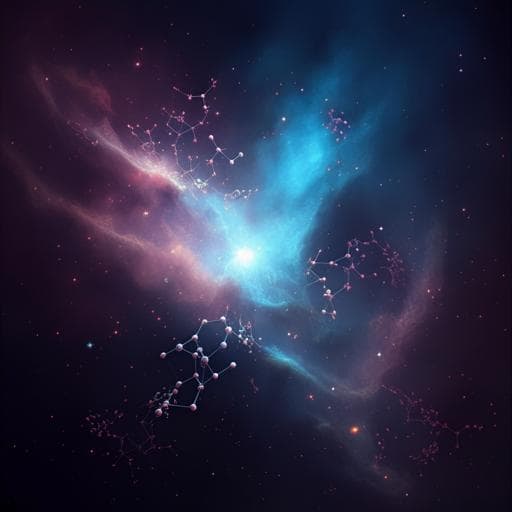
Space Sciences
Efficient stabilization of cyanonaphthalene by fast radiative cooling and implications for the resilience of small PAHs in interstellar clouds
M. H. Stockett, J. N. Bull, et al.
This groundbreaking research by Mark H. Stockett and colleagues reveals that the abundance of cyanonaphthalene in the Taurus Molecular Cloud far exceeds expectations, challenging existing astrophysical models. The study uncovers critical insights into the stability of 1-CNN⁺ and its implications for the understanding of small PAH destruction in space.
~3 min • Beginner • English
Introduction
PAHs are inferred to be widespread in the interstellar medium from their infrared emission bands, but these bands are not species-specific. Prevailing views have held that only large PAHs (>50 carbon atoms) can survive in the ISM due to rapid fragmentation following excitation. Recent radio observations of TMC-1 identified two isomers of cyanonaphthalene, providing the first definitive assignment of a specific PAH in space, yet with abundances six orders of magnitude higher than astrochemical model predictions. This work addresses the discrepancy by testing the hypothesis that small PAH cations, specifically 1-cyanonaphthalene (1-CNN+), can be efficiently stabilized by fast radiative cooling via Recurrent Fluorescence (RF), enhanced by Herzberg–Teller vibronic coupling. The study measures unimolecular dissociation and radiative cooling rates under conditions analogous to interstellar clouds to evaluate the resilience of small PAHs and to inform astrochemical modeling of their formation and destruction.
Literature Review
The paper builds on recent detections of benzonitrile and cyanonaphthalene in the ISM and the broader literature on PAH chemistry in interstellar environments. Prior astrochemical models generally reproduce linear and monocyclic nitrile abundances but substantially underpredict indene and CNNs. Traditional assumptions posit that small PAHs are rapidly destroyed in the ISM unless very large; however, laboratory studies have shown fast radiative cooling via RF for small unsubstituted PAH cations such as naphthalene, anthracene, and perylene. Earlier kinetic and spectroscopic theories of RF and Herzberg–Teller vibronic coupling suggest that low-lying electronic transitions, although weak in the Franck–Condon limit, can be significantly enhanced by vibronic coupling. Previous measurements on benzonitrile and naphthalene-related systems provide benchmark activation energies for dissociation, informing the analysis of 1-CNN+ presented here.
Methodology
Experiments were performed at the DESIREE cryogenic electrostatic ion storage ring (≈13 K, residual gas density ≈10^6 cm−3) at Stockholm University. 1-CNN (Sigma-Aldrich, >96%) was sublimed into an ECR ion source (helium support gas), and cations were accelerated to 34 keV. Mass-selected 1-CNN+ beams (m/z 153) were injected and stored. Two neutral imaging measurements were conducted: (1) a single-pass measurement 120–124 µs after ion formation with a 0.5 mm aperture to limit spatial smearing; (2) stored-beam measurements for 200 ms without apertures, using 1.1 ms exposure frames triggered every 2.5 ms, time-stamped and synchronized with the storage cycle. Neutral fragments formed in the observation straight section were detected by a position-sensitive MCP/phosphor/CMOS imaging detector. Three-dimensional Newton spheres were reconstructed via inverse Abel transform (PyAbel, three-point algorithm). Kinetic energy release (KER) distributions were obtained from the Newton sphere radii using the beam energy (34 keV) and flight distance distribution along the observation arm; contributions from decays along the full straight section length were included, yielding negligible corrections relative to the mid-point assumption. Analysis focused on the dominant HCN-loss channel; H-loss is competitive but detected with very low efficiency and mainly depletes the stored ion beam. The absolute per-particle dissociation rate Γ(t) was extracted from the measured neutral count rate R(t) with corrections for detector efficiency (ηdet = 0.34(3)), ring circumference (C = 8.7 m), observed length (Lss = 0.95 m), and stored ion number N(t), with backgrounds from residual gas and dark counts subtracted. KER distributions were modeled to extract a transient temperature and an Arrhenius-form unimolecular dissociation rate coefficient kdiss(E(T)) with activation energy Ea and pre-exponential factor Adiss, referencing a flat transition state model yielding P(ε) consistent with a reverse barrier ΔE near the centrifugal barrier. The dissociation rate coefficient was also expressed in microcanonical form via inverse Laplace transform: kdiss(E) = Adiss P(E−Ea)/ρ(E), with ρ(E) computed by the Beyer–Swinehart algorithm using vibrational frequencies from DFT (B3LYP/6-31G(d,p), Gaussian 16). Radiative cooling was modeled with a master equation including: (i) IR vibrational emission using the Simple Harmonic Cascade approximation with mode energies hνs and Einstein A coefficients As; (ii) RF emission using kRF(E) = ARF ρ(E−hνel)/ρ(E), with ARF from the oscillator strength f and electronic transition energy νel. Herzberg–Teller vibronic coupling was included via Franck–Condon–Herzberg–Teller simulations (ωB97X-D/cc-pVDZ) to obtain f = 0.011 for the La band; excitation energy hνel = 1.10 eV was calculated at the EOM-CCSD/cc-pVDZ level (CFOUR). The master equation propagated an initially normalized vibrational energy distribution g(E,0) (Boltzmann-like initial conditions tested), with depletion by kdiss(E) (including a branching correction γHCN = 0.70 for HCN-loss) and redistribution by IR and RF emissions. The simulated dissociation rate was computed as Γ(t) = ∫ kdiss(E) g(E,t) dE / ∫ g(E,t) dE and compared with experimental Γ(t).
Key Findings
- KER analysis at t = 120 µs yields a transient temperature T = 1610(20) K and a small reverse barrier ΔE = 6.2(5) meV, consistent with a flat transition state. Fitting of P(ε,t) up to 27.5 ms gives temperatures decreasing from about 1320(10) to 1220(10) K.
- The activation energy for the dominant HCN-loss dissociation channel of 1-CNN+ is Ea = 3.16(4) eV, consistent with values for structurally related systems (e.g., benzonitrile).
- The experimental dissociation rate Γ(t) is reproduced by master equation simulations assuming an initial vibrational temperature of 1970(60) K.
- Inclusion of Herzberg–Teller vibronic coupling is essential: the calculated oscillator strength f = 0.011 for the La ← D0 transition boosts the RF rate coefficient by ~100× compared to neglecting vibronic coupling (f ≈ 1e−4). Simulations without HT (lower f) fail to reproduce the measured quenching unless unrealistically low initial temperatures are assumed.
- Survival probability versus internal energy shows that a single RF photon typically stabilizes 1-CNN+ above the dissociation threshold, whereas IR cooling alone requires multiple photons and is less efficient in the critical energy window.
- RF dominates radiative stabilization over IR for a broad range of internal energies, efficiently quenching unimolecular decay and explaining the resilience of small PAH cations under interstellar-like conditions.
- The efficient RF-stabilization up to a critical vibrational energy Ec ≈ 5 eV implies that neutral 1-CNN is resilient against dissociative ionization by 13.6 eV recombination radiation common in molecular clouds.
Discussion
The findings demonstrate that small PAH cations, exemplified by 1-CNN+, can undergo rapid radiative stabilization via RF when Herzberg–Teller vibronic coupling enhances low-lying electronic transitions. This directly challenges the long-held assumption that small PAHs are rapidly destroyed in the ISM. The measured dissociation kinetics (Ea ≈ 3.16 eV) and the necessity of a substantial RF rate (f ≈ 0.011) imply that, following excitation or reactive encounters, 1-CNN+ can shed internal energy efficiently and avoid fragmentation. This provides a physical mechanism to reconcile the high observed CNN abundances in TMC-1 with laboratory-constrained microcanonical kinetics. The work suggests that astrochemical models likely overestimate CNN destruction rates and underestimate formation or inheritance pathways. In particular, several ion–molecule reactions included in models may proceed predominantly by charge transfer with insufficient excess energy to cause fragmentation, favoring RF-stabilized CNN+. Given the ionization energy of 1-CNN (8.6 eV) and rapid RF below about 5 eV internal energy, photodestruction by typical molecular cloud radiation is also disfavored. Overall, benchmarked calculations including HT coupling are needed for reliable predictions of PAH stability across interstellar environments.
Conclusion
This study provides quantitative laboratory evidence that recurrent fluorescence, strongly enhanced by Herzberg–Teller vibronic coupling, stabilizes vibrationally hot 1-cyanonaphthalene cations on timescales competitive with unimolecular dissociation. The derived activation energy for HCN-loss (3.16(4) eV), observed cooling behavior, and survival probabilities show that a single RF photon can efficiently quench decay, whereas IR cooling alone is insufficient in the critical energy range. These results help explain the anomalously high CNN abundances in TMC-1 and indicate that small PAHs can survive in interstellar environments, necessitating revisions to astrochemical models that assume rapid destruction. Future work should include further laboratory measurements of ion–neutral, electron–ion, and ion–ion reactions of CNN, its precursors, and fragments under astrophysically relevant conditions, alongside theoretical treatments that explicitly include vibronic coupling to predict dissociation and radiative rates.
Limitations
- The analysis and extraction of Γ(t) assume dominance of the HCN-loss channel in the observed neutral count rate; H-loss, though competitive, is detected inefficiently and only accounted for via a branching correction (γHCN = 0.70), introducing uncertainty.
- The simulated dissociation rate deviates from experiment at t > 20 ms, likely due to sequential fragmentation pathways not included explicitly in the kinetic model.
- IR cooling rates in the SHC model and density-of-states calculations carry method-dependent uncertainties (previously estimated within a factor of two), and the deduced Ea and temperatures contribute additional error bands.
- The RF oscillator strength relies on HT-inclusive simulations; neglect or inaccuracies in vibronic coupling modeling would significantly alter predicted stabilization efficiencies.
- Photodestruction processes are discussed qualitatively but not experimentally probed here; the interstellar reaction network implications depend on assumed branching in astrochemical reactions not measured in this study.
Related Publications
Explore these studies to deepen your understanding of the subject.







